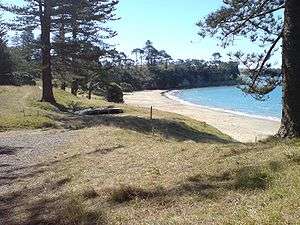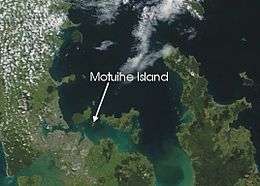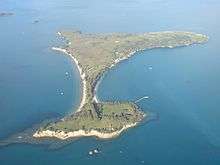Motuihe Island
Motuihe Island lies between Motutapu and Waiheke islands in the Hauraki Gulf of New Zealand, near Auckland. The island measures 179 ha (440 acres),[1] of which around 18 ha (44 acres) are remnants of coastal forest. The island is a recreation reserve controlled by the Department of Conservation (DOC) and administered by the Motuihe Trust. It is a popular spot for day trips, accessible by 30-minute ferry trip from Auckland, by seaplane, or by private boat. The island is known for its beautiful beaches.[2][3]
| Maori: Te Motu-a-Ihenga | |
|---|---|
 The beach on the northern side of the narrow western neck, separated from the southern beach by about 30 m (33 yd) | |
 Location of Motuihe Island in the Hauraki Gulf | |
| Geography | |
| Coordinates | 36.810212°S 174.947019°E |
| Area | 179 ha (440 acres) |
| Administration | |
| Demographics | |
| Population | 1 |

The name comes from Te Motu-a-Ihenga, Māori for 'Ihenga's Island'.[4]
History
The small island has had a colourful human history. Starting out as a Māori settlement place, at least two pā fortification sites are known on the island. The locals are said to have grown gourds and taro. William Fairburn purchased Motuihe in 1839 from William Jowett , Ko Nuki and Te Manago: chiefs of Te Iwi Tutu, Ngāi Tai and Ngatiwaki respectively. They paid one heifer, twenty blankets, ten axes, ten hoes, ten spades, six gowns, two red blankets, 12 dutch pipes, six iron pots and one shawl.
Very soon after arrival of the Europeans in the area, farming began in the 1840s. Groves of Norfolk pines and olive trees are remnants of this time.[4]
In 1872 the island was designated as a human quarantine station for smallpox victims.[5] A quarantine station was built on the western section of the island in 1873. It was used in 1874 for scarlet fever arriving on an inbound ship and operated for almost 50 years, slowly growing in size.
During the First World War, the station was used as an internment camp whose most famous prisoner was Count Felix von Luckner and his crew of the commerce raider SMS Seeadler.[4] Captured in September 1917, in December Luckner used a Christmas play as a ruse to organise an escape. He got provisions and seized the island's launch,[6] a scow. Then sailing to the Kermadec Islands he was recaptured (and escaped again),[4] though not before becoming something of an odd type of hero in the eyes of many New Zealanders, for the fact that his numerous and daring wartime escapades had killed only a single person.
Following the First World War, the island was again used as a quarantine station during the 1918 flu pandemic.
With the outbreak of World War II, the buildings became a naval training base, HMNZS Tamaki, and a number of newer buildings were added. The base remained a navy training ground until 1963, when its functions were moved to the North Shore mainland.[4]
Conservation

The island's trust organises an active programme of pest eradication and is slowly replanting sections of the island with native trees. Rats and mice were eradicated in 1996 and rabbits in 2004.[7] The conservation programme has reintroduced native species like the North Island saddleback (tieke).[8] The Trust maintains a small conservation presence on the island, and usually has a number of volunteers working at the local tree nursery or in other conservation programmes.
In early 2008, rat footprints were found in a tracking tunnel (a device to check for the presence of certain animals) on the island. This set off a substantial effort by the trust and DOC to catch the rodent, which was feared to be part of a larger infestation. The Norwegian rat was eventually trapped by a special hunting dog, allowing plans to release native red-fronted parakeets (kākāriki) to continue as planned[7] in May 2008, when 31 were brought by helicopter from Little Barrier Island, where there is a relatively large population.[9]
In March 2009, fifteen little spotted kiwi were released on the island.[10]
In May 2009, 350 'agents' of The Nikolai Organisation planted 22,400 native trees on Motuihe Island in just one day, which was 40% of the 2009 planting programme.[11][12][13]
In 2017, Ricoh New Zealand employees and customers finally reached their goal of planting 20,000 trees across "Ricoh Valley".
Many invasive weed species are present on Motuihe. Moth plant, woolly nightshade and rhamnus slow the forest's regeneration. They require constant management from the help of volunteers.
See also
- List of islands of New Zealand
- List of islands
- Desert island
References
- "Data Table - Protected Areas - LINZ Data Service (recorded area 178.6433 ha)". Land Information New Zealand. Retrieved 3 September 2019.
- "Motuihe Recreation Reserve". Department of Conservation. Retrieved 27 February 2008.
- "Motuihe Project Archived 14 October 2008 at the Wayback Machine". Motuihe Trust. Retrieved 27 February 2008.
- "Motuihe Recreation Reserve: History". Department of Conservation. Retrieved 27 February 2008.
- Weekes, John (9 February 2020). "Quarantined: A sordid, sickly, sad underside of New Zealand history". Stuff. Retrieved 16 February 2020.
- McSaveney, Eileen (24 September 2007). "Nearshore islands - Quarantine centres and prisons". Te Ara - the Encyclopedia of New Zealand. Retrieved 17 February 2020.
- Eriksen, Alanah (24 April 2008). "Dog traps rat on 'pest-free' gulf island". The New Zealand Herald. Retrieved 26 October 2011.
- "Motuihe Recreation Reserve: Features". Department of Conservation. Retrieved 27 February 2008.
- "Kakariki spread wings on new island home". Massey University. 20 May 2008.
- Gibson, Eloise (23 March 2009). "Tiny kiwi move into a new island home". The New Zealand Herald. Retrieved 26 October 2011.
- Scoop Independent News talks about The Nikolai Organisation planting 22,400 trees to beat Eco-Record
- Hume, Tim (10 May 2009). "Do-good 'secret society' to invade Hauraki Gulf". The Sunday Star-Times. Retrieved 26 October 2011.
- "Secret Agents' Storm New Eco-Record And Plant A 22,400-tree Forest in a Day on Motuihe Island". Voxy Online News. Retrieved 13 July 2010.
External links
| Wikimedia Commons has media related to Motuihe Island. |
- Motuihe Trust
- Photographs of Motuihe Island held in Auckland Libraries' heritage collections.